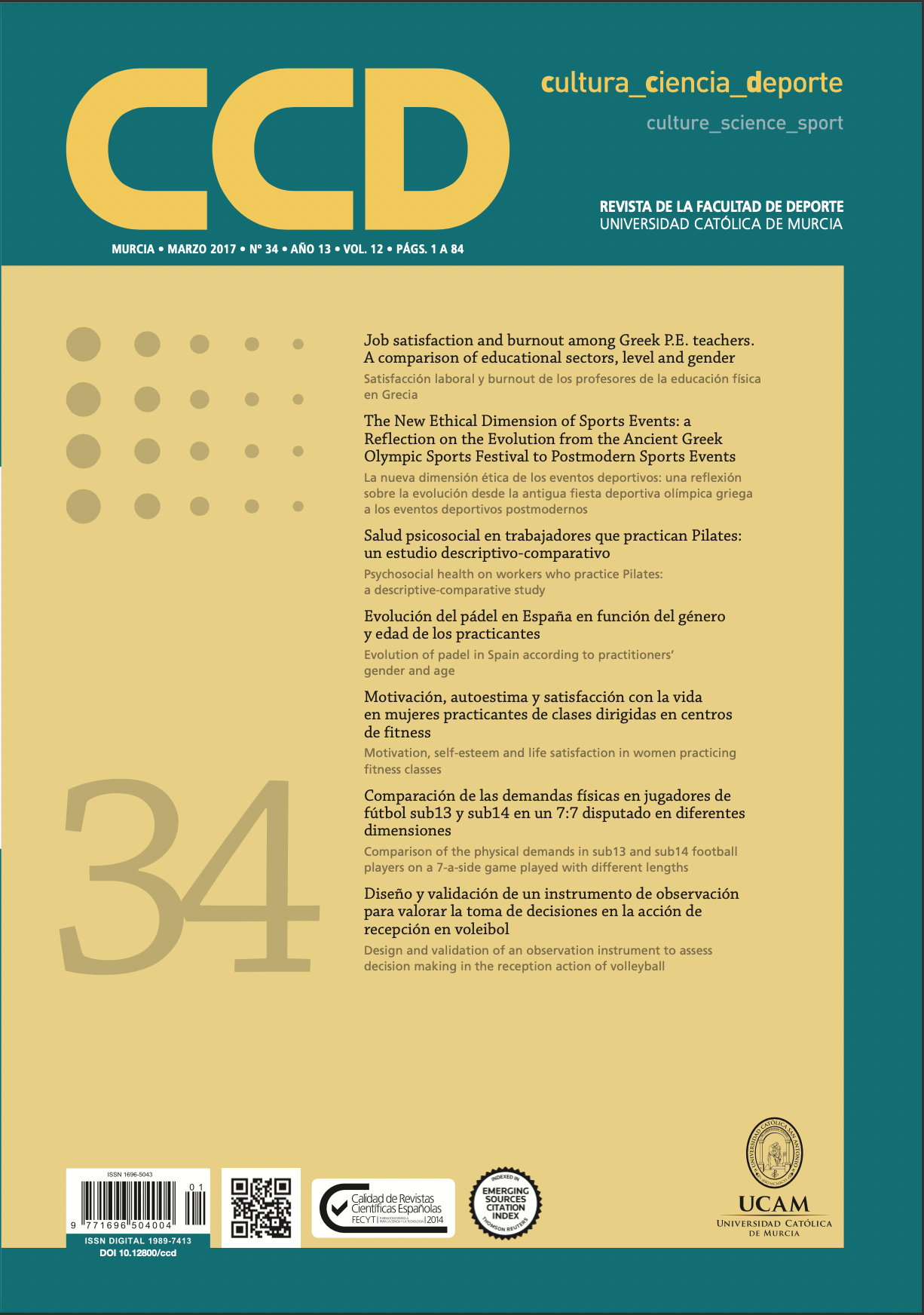Comparación de las demandas físicas en jugadores de fútbol sub13 y sub14 en un 7:7 disputado en diferentes dimensiones. (Comparison of the physical demands in sub13 and sub14 football players on a 7-a-side game played with different lengths).
DOI:
https://doi.org/10.12800/ccd.v12i34.832Resumen
El objetivo del estudio fue analizar la influencia de un juego reducido (JR) con cuatro larguras diferentes en las demandas físicas en 28 jugadores infantiles de fútbol, divididos en grupos de edad sub13 y sub14. Se jugó un 7 contra 7 (incluido portero) en los siguientes formatos de JR: 60x40m (JR60), 50x40m (JR50), 40x40m (JR40) y 30x40m (JR30), largo por ancho respectivamente. Las variables fueron analizadas a partir de dispositivos GPS: distancia total (DT) y distancia recorrida en rangos absolutos (D0-7, D7-14, D14-17, D17-21 y D>21, todo en Km·h-1) y relativos (D<40%, D40-60% [D<60%] y D>60% de la velocidad máxima individual) de velocidad, ratio trabajo:descanso (W:R), Player Load en tres (PL) y dos (PL2D) planos de movimiento, Exertion Index (EI), Velocidad máxima (Vmax) y Metabolic Power (MP). Los resultados fueron: un aumento de las dimensiones incrementó las demandas físicas en todas las variables excepto en D<7 y D<40%, en sub13 y sub14, aunque no se dio la misma proporción. Sub14 presentó valores superiores a sub13 en las variables DT, EI, MP, Vmax, D17-21 y D>21, lo que parece indicar que este grupo de edad mostró una mayor respuesta condicional cuando las dimensiones del campo así lo permitieron. Por el contrario, en valores relativos (D<60% y D>60%) los sub13 mostraron mayor carga que sub14. La principal aplicación del estudio permitiría conocer las dimensiones que son adecuadas para cada categoría de edad, para que no supongan estas una limitación desde el punto de vista condicional.
Palabras clave: Deporte colectivo, juego reducido, análisis del movimiento, formación.
===
Abstract The aim of the present study was to analyze the influence of one small-sided game (SSG) with four different pitch lengths on the physical demands in young soccer players, within theU13 and U14 age groups. One 7-a-side game (goalkeeper included) was played in the following SSG formats: 60x40m (SSG60), 50x40m (SSG50), 40x40m (SSG40) and 30x40m (SSG30), length times width respectively. Using GPS devices, the variables analyzed were: total distance (TD) and distance covered in absolute ranges (D0-7, D7-14, D14-17, D17-21 and D>21, all in Km·h-1) and relatives (D<40%, D40-60% [D<60%] and D>60% of the individual maximal speed) of velocity, work:rest ratio (W:R); player-load in three (PL) or two (PL2D) planes of movement, Exertion Index (EI), Maximal Velocity (Vmax) and metabolic Power (MP). The results were: when pitch dimensions increase higher values in all variables were found except D<7 and D>40%, in U13 and U14, although it was not the same proportion. U14 had higher values than U13 in the variables DT, EI, MP, Vmax, D17-21 and D>21, suggesting that this age group showed a higher conditional response when field dimensions allow it. To the contrary, in relative values (D<60% and D>60%) the U13 showed higher load scores than U14. The main application of this study would be to know which dimensions are adequate for each age, notwithstanding the limitation of physical conditioning.
Key words: Team sport, small-sided game, time motion, training.
Descargas
Publicado
Cómo citar
Número
Sección
Licencia
Los autores que publican en esta revista están de acuerdo con los siguientes términos:- Los autores conservan los derechos de autor y garantizan a la revista el derecho de ser la primera publicación del trabajo al igual que licenciado bajo una Creative Commons Attribution License que permite a otros compartir el trabajo con un reconocimiento de la autoría del trabajo y la publicación inicial en esta revista.













